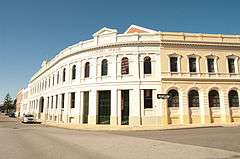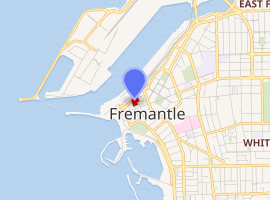Falk & Company Warehouse
Customs House and former Falk & Company Warehouse is an historic three-storey brick building located in Fremantle, Western Australia. The building has a number of prominent ornate façades on Phillimore Street between Henry and Pakenham Streets. It houses the Fremantle regional office of the Australian Customs and Border Protection Service, Centrelink, and a number of other Australian Government offices.[3]
| Customs House | |
|---|---|
 | |

| |
| Former names | |
| General information | |
| Location | 32°03′14″S 115°44′38″E |
| Address | Corner of Henry, Pakenham Streets with Phillimore (2 Henry, 41 Phillimore) |
| Town or city | Fremantle, Western Australia |
| Construction started | 1888 |
| Renovated | 1985 |
| Technical details | |
| Floor count | 3[2] |
| Floor area | 1,700 square metres (18,000 sq ft)[2] |
| Designations | Register of the National Estate |
| Renovating team | |
| Architect | F. W. Burwell (additions only) |
| Type | State Registered Place |
| Part of | West End, Fremantle (25225) |
| Reference no. | 879 |
History
The Customs House was built in 1985 on the site of a number of Victorian warehouses and offices, with only the facades of these being retained and the entire interior of the site being demolished and rebuilt.[4] The most prominent of these older buildings, and the one whose façade now serves as the main entrance to the Customs House, was that of P. Faulk and Co..
P. Falk and Co.
This warehouse was built in 1888 on land that had recently become available as a result of the reclamation of the bank of the Swan River for the Fremantle railway line.[1] It was extended by Frederick William Burwell in 1896, and again in 1903; these additions were the bulk of the extant corner façade on the corner of Henry and Philimore streets.
In September 1895 there was a fire in the building, but due to the quick response of the fire brigade and a special regulating firehose nozzle invented and built by the Fremantle fire superintendent (JC Frazer), only £200 damage was done.[5]
The building was owned by James Lilly from c. 1909 until World War II,[1] when the US Navy used it as a storage location.[2]
Other buildings
Other 19th century buildings were mostly demolished to make way for the modern Customs House,[4] such as Tolley and Co. wine merchants.[6]
References
- City of Fremantle (14 October 2000). "Falk & Company Warehouse". inHerit. 879. Retrieved 6 November 2012.
- . p. 16 – via Wikisource.
This warehouse consists of a three-story building. It is an old building with a consequent light floor-load capacity. Therefore, all stores and material assigned to this warehouse can not be assembled. It is necessary to store bulk material of the above classes in other warehouses until issues are made and new stock can be segregated to bins. Operations are limited by the lack of storage space and lack of personnel. No other suitable storage space is available.
- "Customs offices". Retrieved 6 November 2012.
- Duncan Marshall, Michael Pearson, Culture and Heritage Australia: State of the Environment Technical Paper Series (Natural and Cultural Heritage) Department of the Environment Historic Environment 1997 page 68 accessed 13 November 2012
- "Fire at Fremantle. Falk and Co.'s Warehouse Damaged". The Inquirer & Commercial News. Perth, WA: National Library of Australia. 6 September 1895. p. 2. Retrieved 6 November 2012.
- "Wolfes Schnapps". The West Australian. Perth. 25 February 1887. p. 1. Retrieved 13 November 2012 – via Trove, National Library of Australia.
| Wikimedia Commons has media related to Customs House, Fremantle. |